Rise of STIs in Hispanics in US
VerifiedAdded on 2022/12/14
|14
|3787
|459
AI Summary
This annotated bibliography explores the rate of sexually transmitted infections (STIs) in the Hispanic population in the US and its impact on their physical and mental health. It includes quantitative, qualitative, and mixed research articles on the topic.
Contribute Materials
Your contribution can guide someone’s learning journey. Share your
documents today.
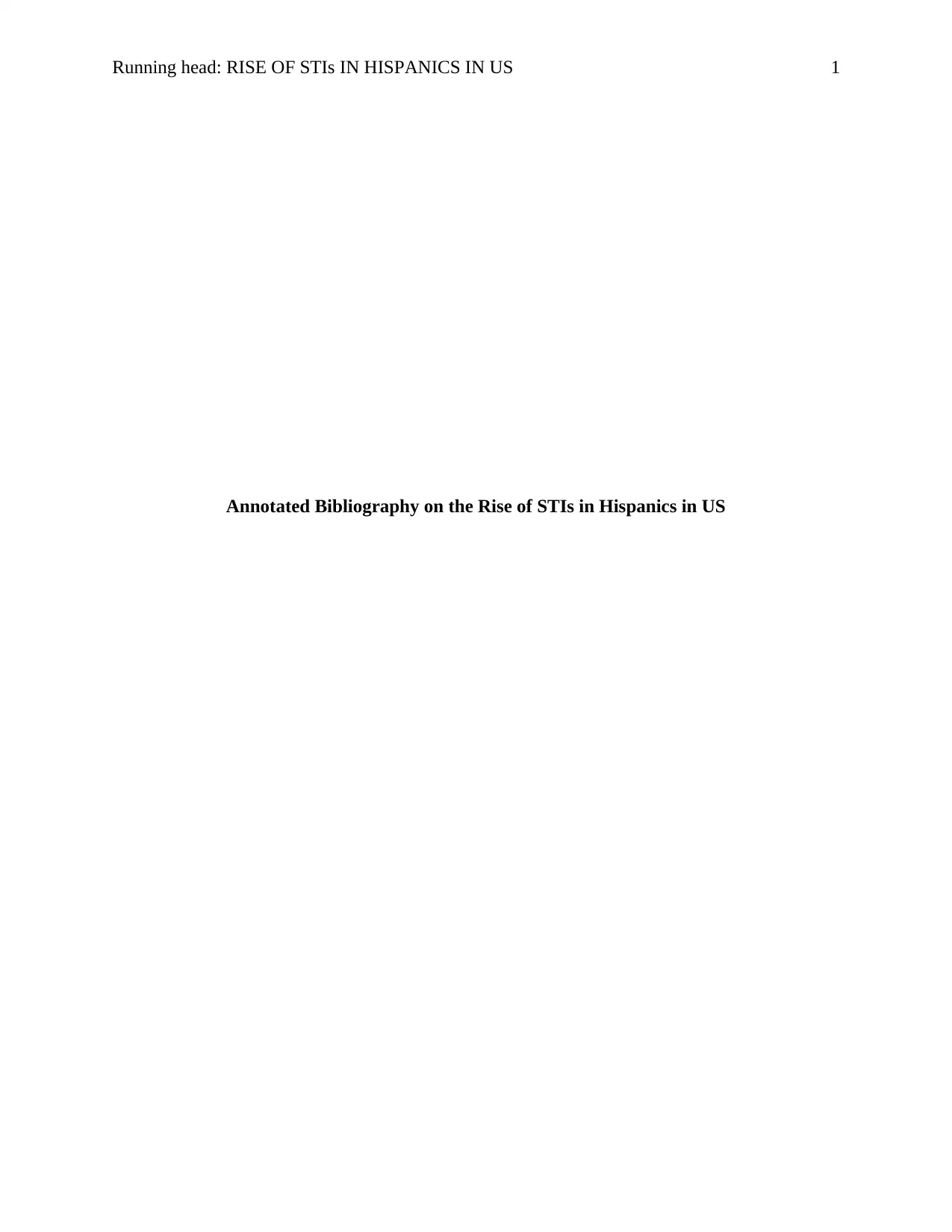
Running head: RISE OF STIs IN HISPANICS IN US 1
Annotated Bibliography on the Rise of STIs in Hispanics in US
Annotated Bibliography on the Rise of STIs in Hispanics in US
Secure Best Marks with AI Grader
Need help grading? Try our AI Grader for instant feedback on your assignments.
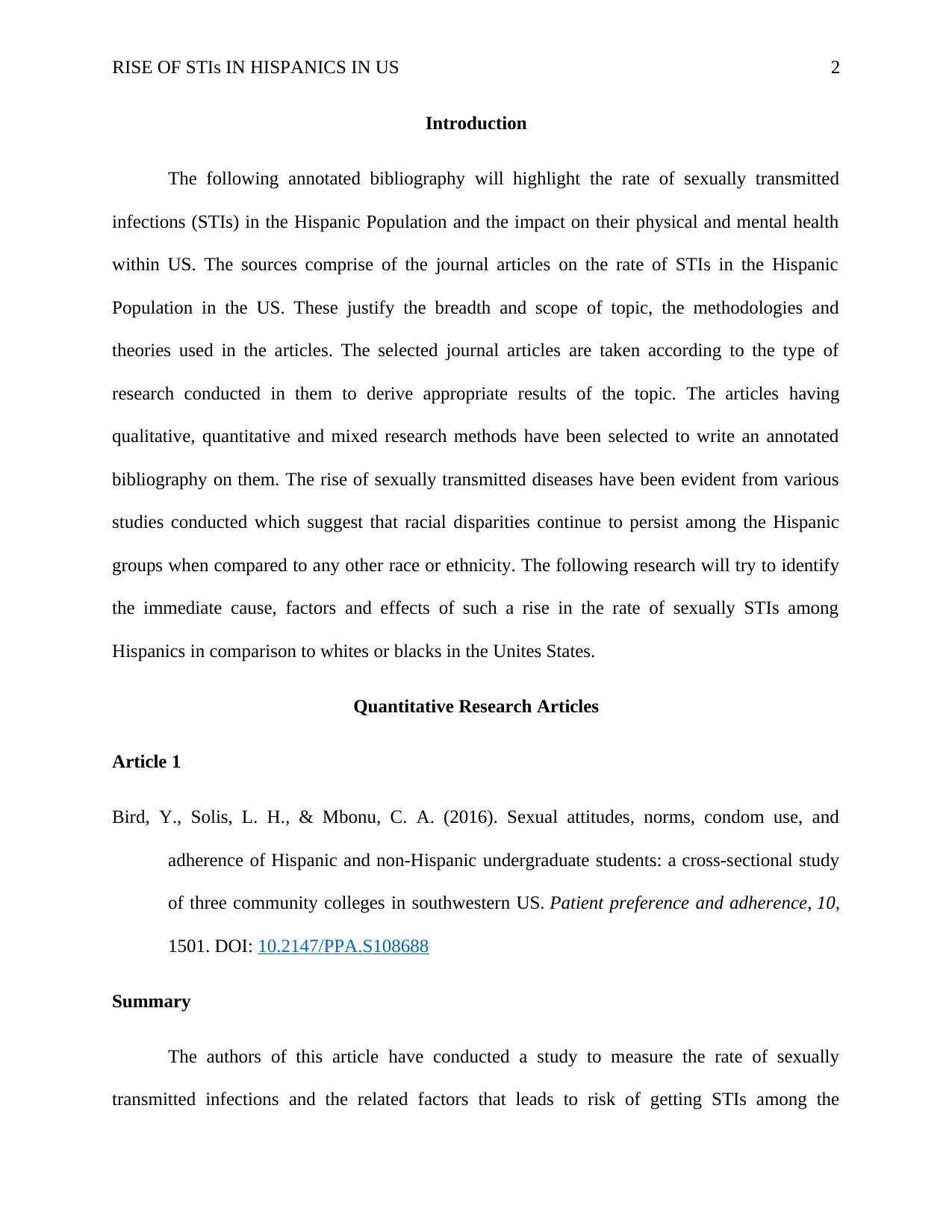
RISE OF STIs IN HISPANICS IN US 2
Introduction
The following annotated bibliography will highlight the rate of sexually transmitted
infections (STIs) in the Hispanic Population and the impact on their physical and mental health
within US. The sources comprise of the journal articles on the rate of STIs in the Hispanic
Population in the US. These justify the breadth and scope of topic, the methodologies and
theories used in the articles. The selected journal articles are taken according to the type of
research conducted in them to derive appropriate results of the topic. The articles having
qualitative, quantitative and mixed research methods have been selected to write an annotated
bibliography on them. The rise of sexually transmitted diseases have been evident from various
studies conducted which suggest that racial disparities continue to persist among the Hispanic
groups when compared to any other race or ethnicity. The following research will try to identify
the immediate cause, factors and effects of such a rise in the rate of sexually STIs among
Hispanics in comparison to whites or blacks in the Unites States.
Quantitative Research Articles
Article 1
Bird, Y., Solis, L. H., & Mbonu, C. A. (2016). Sexual attitudes, norms, condom use, and
adherence of Hispanic and non-Hispanic undergraduate students: a cross-sectional study
of three community colleges in southwestern US. Patient preference and adherence, 10,
1501. DOI: 10.2147/PPA.S108688
Summary
The authors of this article have conducted a study to measure the rate of sexually
transmitted infections and the related factors that leads to risk of getting STIs among the
Introduction
The following annotated bibliography will highlight the rate of sexually transmitted
infections (STIs) in the Hispanic Population and the impact on their physical and mental health
within US. The sources comprise of the journal articles on the rate of STIs in the Hispanic
Population in the US. These justify the breadth and scope of topic, the methodologies and
theories used in the articles. The selected journal articles are taken according to the type of
research conducted in them to derive appropriate results of the topic. The articles having
qualitative, quantitative and mixed research methods have been selected to write an annotated
bibliography on them. The rise of sexually transmitted diseases have been evident from various
studies conducted which suggest that racial disparities continue to persist among the Hispanic
groups when compared to any other race or ethnicity. The following research will try to identify
the immediate cause, factors and effects of such a rise in the rate of sexually STIs among
Hispanics in comparison to whites or blacks in the Unites States.
Quantitative Research Articles
Article 1
Bird, Y., Solis, L. H., & Mbonu, C. A. (2016). Sexual attitudes, norms, condom use, and
adherence of Hispanic and non-Hispanic undergraduate students: a cross-sectional study
of three community colleges in southwestern US. Patient preference and adherence, 10,
1501. DOI: 10.2147/PPA.S108688
Summary
The authors of this article have conducted a study to measure the rate of sexually
transmitted infections and the related factors that leads to risk of getting STIs among the
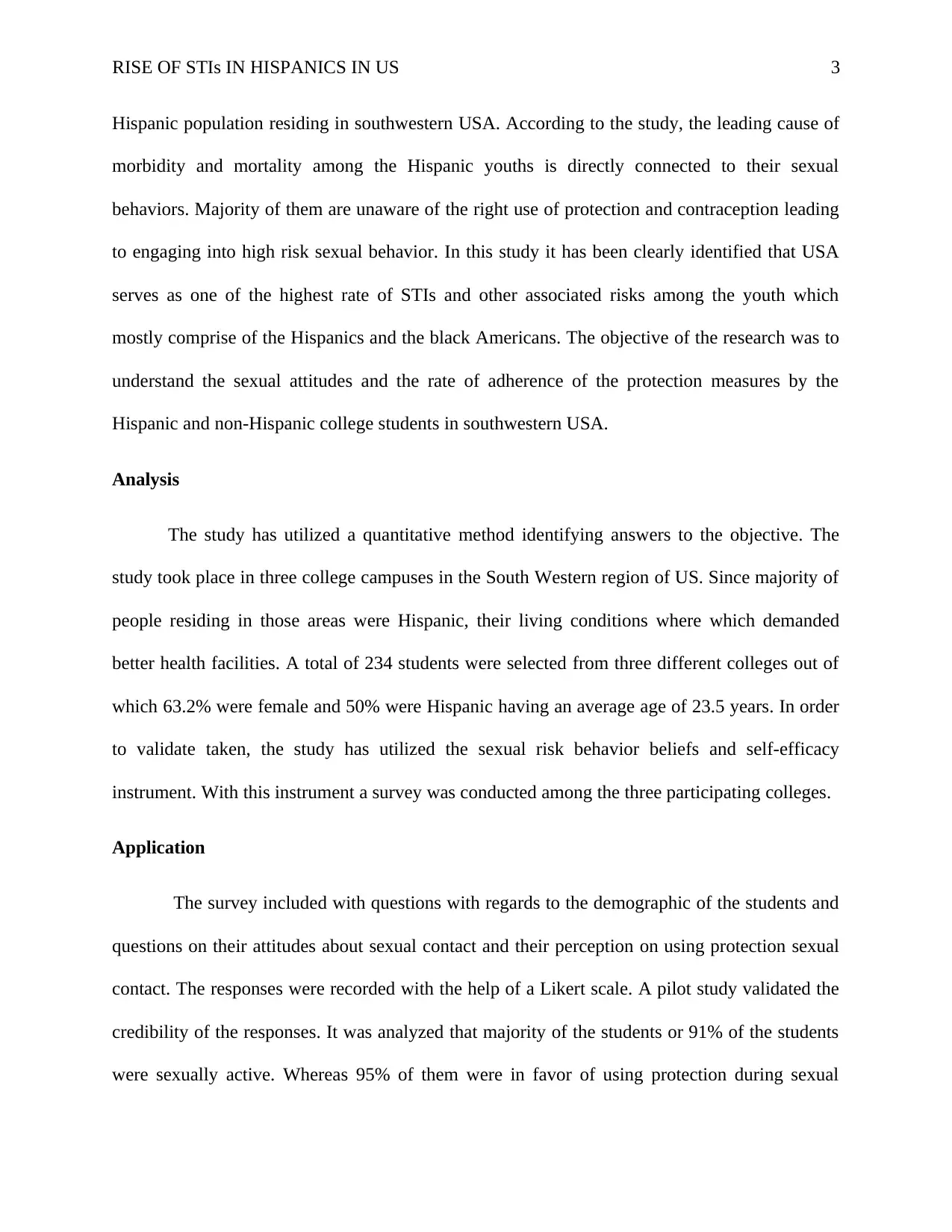
RISE OF STIs IN HISPANICS IN US 3
Hispanic population residing in southwestern USA. According to the study, the leading cause of
morbidity and mortality among the Hispanic youths is directly connected to their sexual
behaviors. Majority of them are unaware of the right use of protection and contraception leading
to engaging into high risk sexual behavior. In this study it has been clearly identified that USA
serves as one of the highest rate of STIs and other associated risks among the youth which
mostly comprise of the Hispanics and the black Americans. The objective of the research was to
understand the sexual attitudes and the rate of adherence of the protection measures by the
Hispanic and non-Hispanic college students in southwestern USA.
Analysis
The study has utilized a quantitative method identifying answers to the objective. The
study took place in three college campuses in the South Western region of US. Since majority of
people residing in those areas were Hispanic, their living conditions where which demanded
better health facilities. A total of 234 students were selected from three different colleges out of
which 63.2% were female and 50% were Hispanic having an average age of 23.5 years. In order
to validate taken, the study has utilized the sexual risk behavior beliefs and self-efficacy
instrument. With this instrument a survey was conducted among the three participating colleges.
Application
The survey included with questions with regards to the demographic of the students and
questions on their attitudes about sexual contact and their perception on using protection sexual
contact. The responses were recorded with the help of a Likert scale. A pilot study validated the
credibility of the responses. It was analyzed that majority of the students or 91% of the students
were sexually active. Whereas 95% of them were in favor of using protection during sexual
Hispanic population residing in southwestern USA. According to the study, the leading cause of
morbidity and mortality among the Hispanic youths is directly connected to their sexual
behaviors. Majority of them are unaware of the right use of protection and contraception leading
to engaging into high risk sexual behavior. In this study it has been clearly identified that USA
serves as one of the highest rate of STIs and other associated risks among the youth which
mostly comprise of the Hispanics and the black Americans. The objective of the research was to
understand the sexual attitudes and the rate of adherence of the protection measures by the
Hispanic and non-Hispanic college students in southwestern USA.
Analysis
The study has utilized a quantitative method identifying answers to the objective. The
study took place in three college campuses in the South Western region of US. Since majority of
people residing in those areas were Hispanic, their living conditions where which demanded
better health facilities. A total of 234 students were selected from three different colleges out of
which 63.2% were female and 50% were Hispanic having an average age of 23.5 years. In order
to validate taken, the study has utilized the sexual risk behavior beliefs and self-efficacy
instrument. With this instrument a survey was conducted among the three participating colleges.
Application
The survey included with questions with regards to the demographic of the students and
questions on their attitudes about sexual contact and their perception on using protection sexual
contact. The responses were recorded with the help of a Likert scale. A pilot study validated the
credibility of the responses. It was analyzed that majority of the students or 91% of the students
were sexually active. Whereas 95% of them were in favor of using protection during sexual
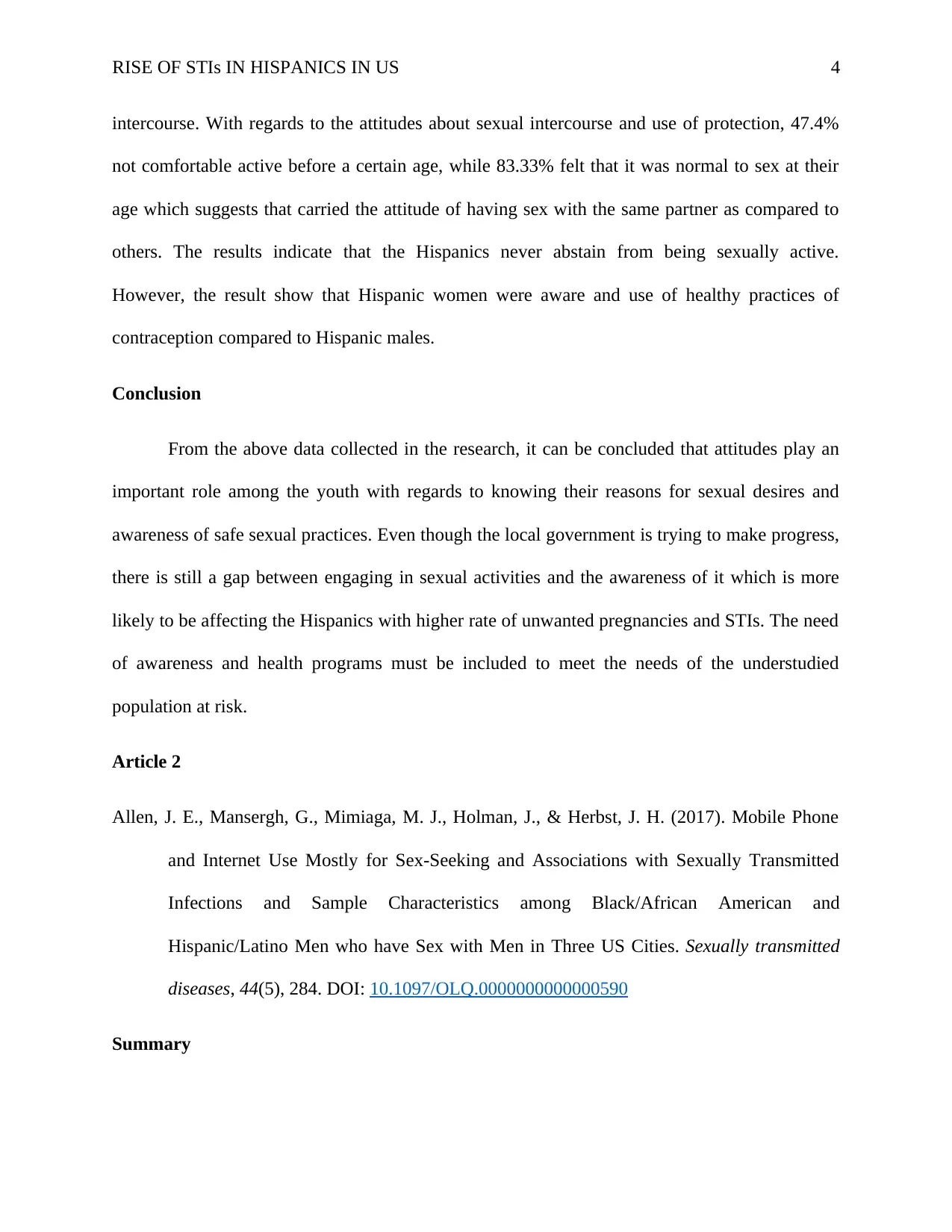
RISE OF STIs IN HISPANICS IN US 4
intercourse. With regards to the attitudes about sexual intercourse and use of protection, 47.4%
not comfortable active before a certain age, while 83.33% felt that it was normal to sex at their
age which suggests that carried the attitude of having sex with the same partner as compared to
others. The results indicate that the Hispanics never abstain from being sexually active.
However, the result show that Hispanic women were aware and use of healthy practices of
contraception compared to Hispanic males.
Conclusion
From the above data collected in the research, it can be concluded that attitudes play an
important role among the youth with regards to knowing their reasons for sexual desires and
awareness of safe sexual practices. Even though the local government is trying to make progress,
there is still a gap between engaging in sexual activities and the awareness of it which is more
likely to be affecting the Hispanics with higher rate of unwanted pregnancies and STIs. The need
of awareness and health programs must be included to meet the needs of the understudied
population at risk.
Article 2
Allen, J. E., Mansergh, G., Mimiaga, M. J., Holman, J., & Herbst, J. H. (2017). Mobile Phone
and Internet Use Mostly for Sex-Seeking and Associations with Sexually Transmitted
Infections and Sample Characteristics among Black/African American and
Hispanic/Latino Men who have Sex with Men in Three US Cities. Sexually transmitted
diseases, 44(5), 284. DOI: 10.1097/OLQ.0000000000000590
Summary
intercourse. With regards to the attitudes about sexual intercourse and use of protection, 47.4%
not comfortable active before a certain age, while 83.33% felt that it was normal to sex at their
age which suggests that carried the attitude of having sex with the same partner as compared to
others. The results indicate that the Hispanics never abstain from being sexually active.
However, the result show that Hispanic women were aware and use of healthy practices of
contraception compared to Hispanic males.
Conclusion
From the above data collected in the research, it can be concluded that attitudes play an
important role among the youth with regards to knowing their reasons for sexual desires and
awareness of safe sexual practices. Even though the local government is trying to make progress,
there is still a gap between engaging in sexual activities and the awareness of it which is more
likely to be affecting the Hispanics with higher rate of unwanted pregnancies and STIs. The need
of awareness and health programs must be included to meet the needs of the understudied
population at risk.
Article 2
Allen, J. E., Mansergh, G., Mimiaga, M. J., Holman, J., & Herbst, J. H. (2017). Mobile Phone
and Internet Use Mostly for Sex-Seeking and Associations with Sexually Transmitted
Infections and Sample Characteristics among Black/African American and
Hispanic/Latino Men who have Sex with Men in Three US Cities. Sexually transmitted
diseases, 44(5), 284. DOI: 10.1097/OLQ.0000000000000590
Summary
Secure Best Marks with AI Grader
Need help grading? Try our AI Grader for instant feedback on your assignments.
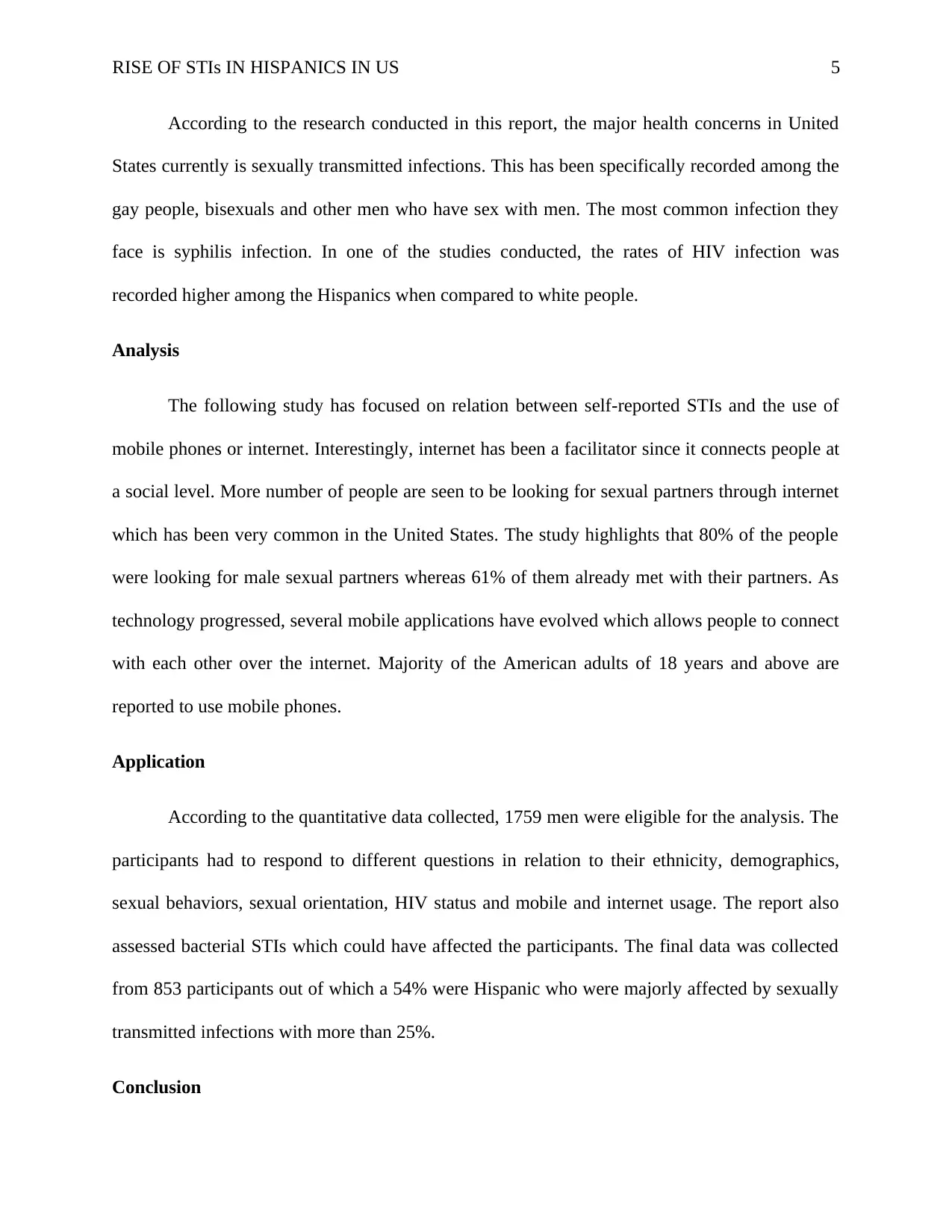
RISE OF STIs IN HISPANICS IN US 5
According to the research conducted in this report, the major health concerns in United
States currently is sexually transmitted infections. This has been specifically recorded among the
gay people, bisexuals and other men who have sex with men. The most common infection they
face is syphilis infection. In one of the studies conducted, the rates of HIV infection was
recorded higher among the Hispanics when compared to white people.
Analysis
The following study has focused on relation between self-reported STIs and the use of
mobile phones or internet. Interestingly, internet has been a facilitator since it connects people at
a social level. More number of people are seen to be looking for sexual partners through internet
which has been very common in the United States. The study highlights that 80% of the people
were looking for male sexual partners whereas 61% of them already met with their partners. As
technology progressed, several mobile applications have evolved which allows people to connect
with each other over the internet. Majority of the American adults of 18 years and above are
reported to use mobile phones.
Application
According to the quantitative data collected, 1759 men were eligible for the analysis. The
participants had to respond to different questions in relation to their ethnicity, demographics,
sexual behaviors, sexual orientation, HIV status and mobile and internet usage. The report also
assessed bacterial STIs which could have affected the participants. The final data was collected
from 853 participants out of which a 54% were Hispanic who were majorly affected by sexually
transmitted infections with more than 25%.
Conclusion
According to the research conducted in this report, the major health concerns in United
States currently is sexually transmitted infections. This has been specifically recorded among the
gay people, bisexuals and other men who have sex with men. The most common infection they
face is syphilis infection. In one of the studies conducted, the rates of HIV infection was
recorded higher among the Hispanics when compared to white people.
Analysis
The following study has focused on relation between self-reported STIs and the use of
mobile phones or internet. Interestingly, internet has been a facilitator since it connects people at
a social level. More number of people are seen to be looking for sexual partners through internet
which has been very common in the United States. The study highlights that 80% of the people
were looking for male sexual partners whereas 61% of them already met with their partners. As
technology progressed, several mobile applications have evolved which allows people to connect
with each other over the internet. Majority of the American adults of 18 years and above are
reported to use mobile phones.
Application
According to the quantitative data collected, 1759 men were eligible for the analysis. The
participants had to respond to different questions in relation to their ethnicity, demographics,
sexual behaviors, sexual orientation, HIV status and mobile and internet usage. The report also
assessed bacterial STIs which could have affected the participants. The final data was collected
from 853 participants out of which a 54% were Hispanic who were majorly affected by sexually
transmitted infections with more than 25%.
Conclusion
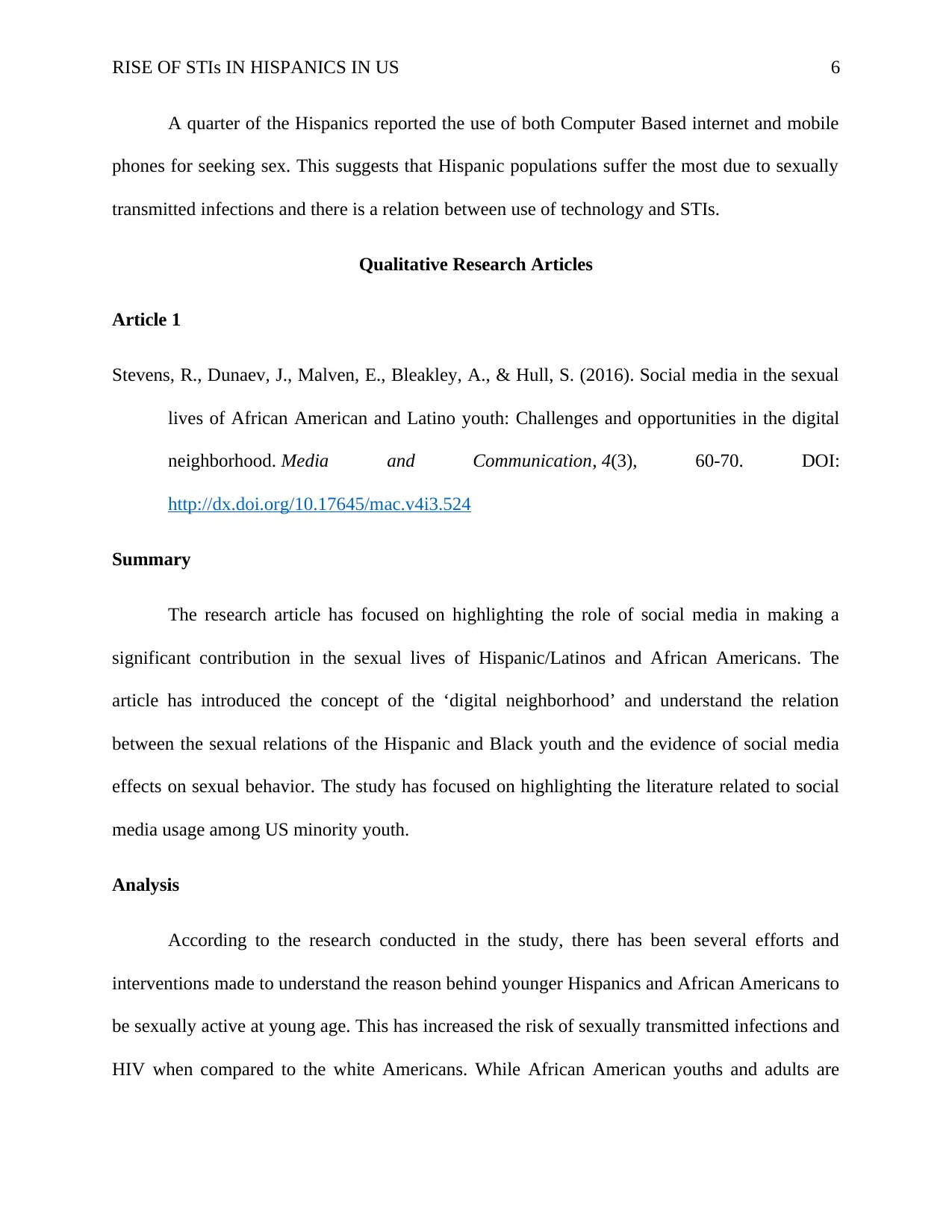
RISE OF STIs IN HISPANICS IN US 6
A quarter of the Hispanics reported the use of both Computer Based internet and mobile
phones for seeking sex. This suggests that Hispanic populations suffer the most due to sexually
transmitted infections and there is a relation between use of technology and STIs.
Qualitative Research Articles
Article 1
Stevens, R., Dunaev, J., Malven, E., Bleakley, A., & Hull, S. (2016). Social media in the sexual
lives of African American and Latino youth: Challenges and opportunities in the digital
neighborhood. Media and Communication, 4(3), 60-70. DOI:
http://dx.doi.org/10.17645/mac.v4i3.524
Summary
The research article has focused on highlighting the role of social media in making a
significant contribution in the sexual lives of Hispanic/Latinos and African Americans. The
article has introduced the concept of the ‘digital neighborhood’ and understand the relation
between the sexual relations of the Hispanic and Black youth and the evidence of social media
effects on sexual behavior. The study has focused on highlighting the literature related to social
media usage among US minority youth.
Analysis
According to the research conducted in the study, there has been several efforts and
interventions made to understand the reason behind younger Hispanics and African Americans to
be sexually active at young age. This has increased the risk of sexually transmitted infections and
HIV when compared to the white Americans. While African American youths and adults are
A quarter of the Hispanics reported the use of both Computer Based internet and mobile
phones for seeking sex. This suggests that Hispanic populations suffer the most due to sexually
transmitted infections and there is a relation between use of technology and STIs.
Qualitative Research Articles
Article 1
Stevens, R., Dunaev, J., Malven, E., Bleakley, A., & Hull, S. (2016). Social media in the sexual
lives of African American and Latino youth: Challenges and opportunities in the digital
neighborhood. Media and Communication, 4(3), 60-70. DOI:
http://dx.doi.org/10.17645/mac.v4i3.524
Summary
The research article has focused on highlighting the role of social media in making a
significant contribution in the sexual lives of Hispanic/Latinos and African Americans. The
article has introduced the concept of the ‘digital neighborhood’ and understand the relation
between the sexual relations of the Hispanic and Black youth and the evidence of social media
effects on sexual behavior. The study has focused on highlighting the literature related to social
media usage among US minority youth.
Analysis
According to the research conducted in the study, there has been several efforts and
interventions made to understand the reason behind younger Hispanics and African Americans to
be sexually active at young age. This has increased the risk of sexually transmitted infections and
HIV when compared to the white Americans. While African American youths and adults are
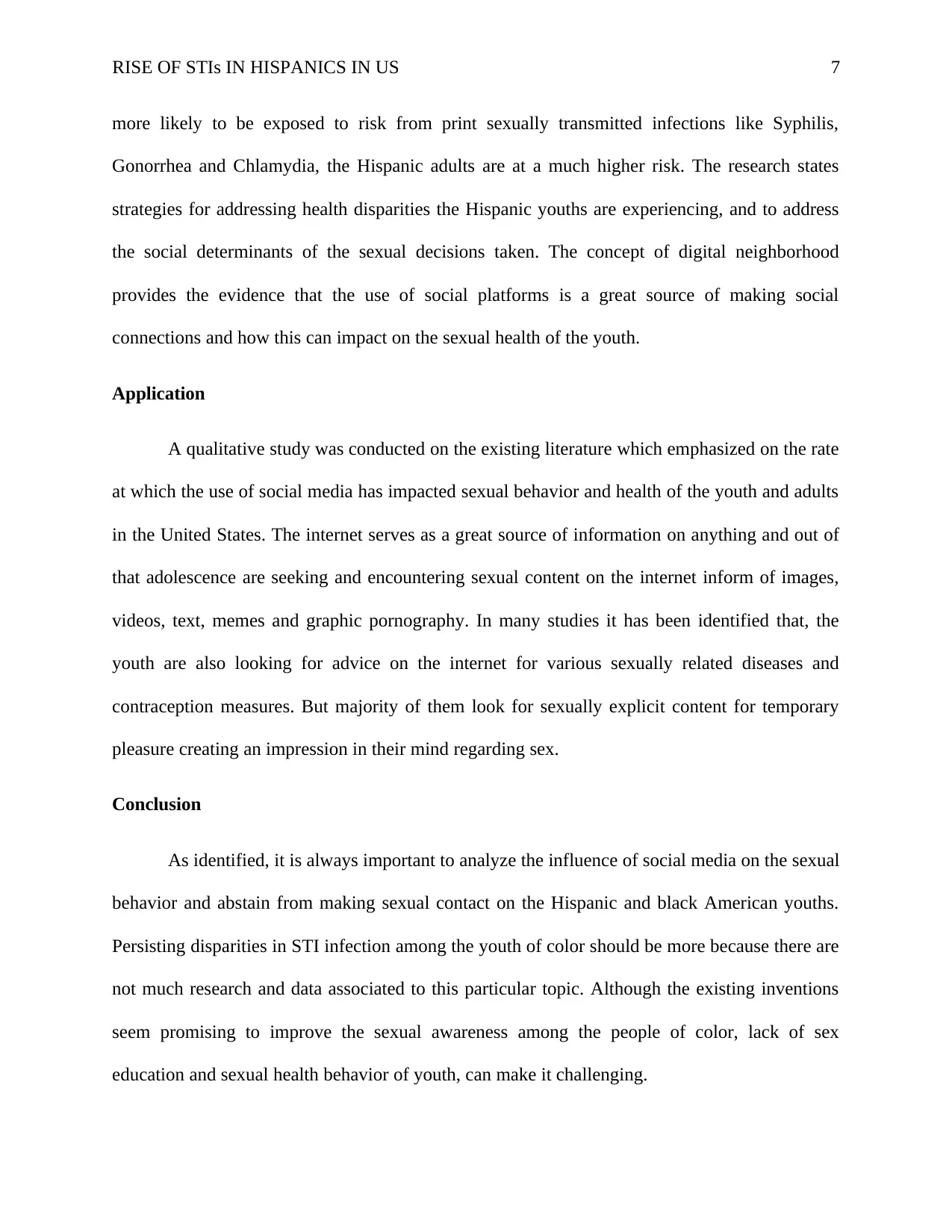
RISE OF STIs IN HISPANICS IN US 7
more likely to be exposed to risk from print sexually transmitted infections like Syphilis,
Gonorrhea and Chlamydia, the Hispanic adults are at a much higher risk. The research states
strategies for addressing health disparities the Hispanic youths are experiencing, and to address
the social determinants of the sexual decisions taken. The concept of digital neighborhood
provides the evidence that the use of social platforms is a great source of making social
connections and how this can impact on the sexual health of the youth.
Application
A qualitative study was conducted on the existing literature which emphasized on the rate
at which the use of social media has impacted sexual behavior and health of the youth and adults
in the United States. The internet serves as a great source of information on anything and out of
that adolescence are seeking and encountering sexual content on the internet inform of images,
videos, text, memes and graphic pornography. In many studies it has been identified that, the
youth are also looking for advice on the internet for various sexually related diseases and
contraception measures. But majority of them look for sexually explicit content for temporary
pleasure creating an impression in their mind regarding sex.
Conclusion
As identified, it is always important to analyze the influence of social media on the sexual
behavior and abstain from making sexual contact on the Hispanic and black American youths.
Persisting disparities in STI infection among the youth of color should be more because there are
not much research and data associated to this particular topic. Although the existing inventions
seem promising to improve the sexual awareness among the people of color, lack of sex
education and sexual health behavior of youth, can make it challenging.
more likely to be exposed to risk from print sexually transmitted infections like Syphilis,
Gonorrhea and Chlamydia, the Hispanic adults are at a much higher risk. The research states
strategies for addressing health disparities the Hispanic youths are experiencing, and to address
the social determinants of the sexual decisions taken. The concept of digital neighborhood
provides the evidence that the use of social platforms is a great source of making social
connections and how this can impact on the sexual health of the youth.
Application
A qualitative study was conducted on the existing literature which emphasized on the rate
at which the use of social media has impacted sexual behavior and health of the youth and adults
in the United States. The internet serves as a great source of information on anything and out of
that adolescence are seeking and encountering sexual content on the internet inform of images,
videos, text, memes and graphic pornography. In many studies it has been identified that, the
youth are also looking for advice on the internet for various sexually related diseases and
contraception measures. But majority of them look for sexually explicit content for temporary
pleasure creating an impression in their mind regarding sex.
Conclusion
As identified, it is always important to analyze the influence of social media on the sexual
behavior and abstain from making sexual contact on the Hispanic and black American youths.
Persisting disparities in STI infection among the youth of color should be more because there are
not much research and data associated to this particular topic. Although the existing inventions
seem promising to improve the sexual awareness among the people of color, lack of sex
education and sexual health behavior of youth, can make it challenging.
Paraphrase This Document
Need a fresh take? Get an instant paraphrase of this document with our AI Paraphraser
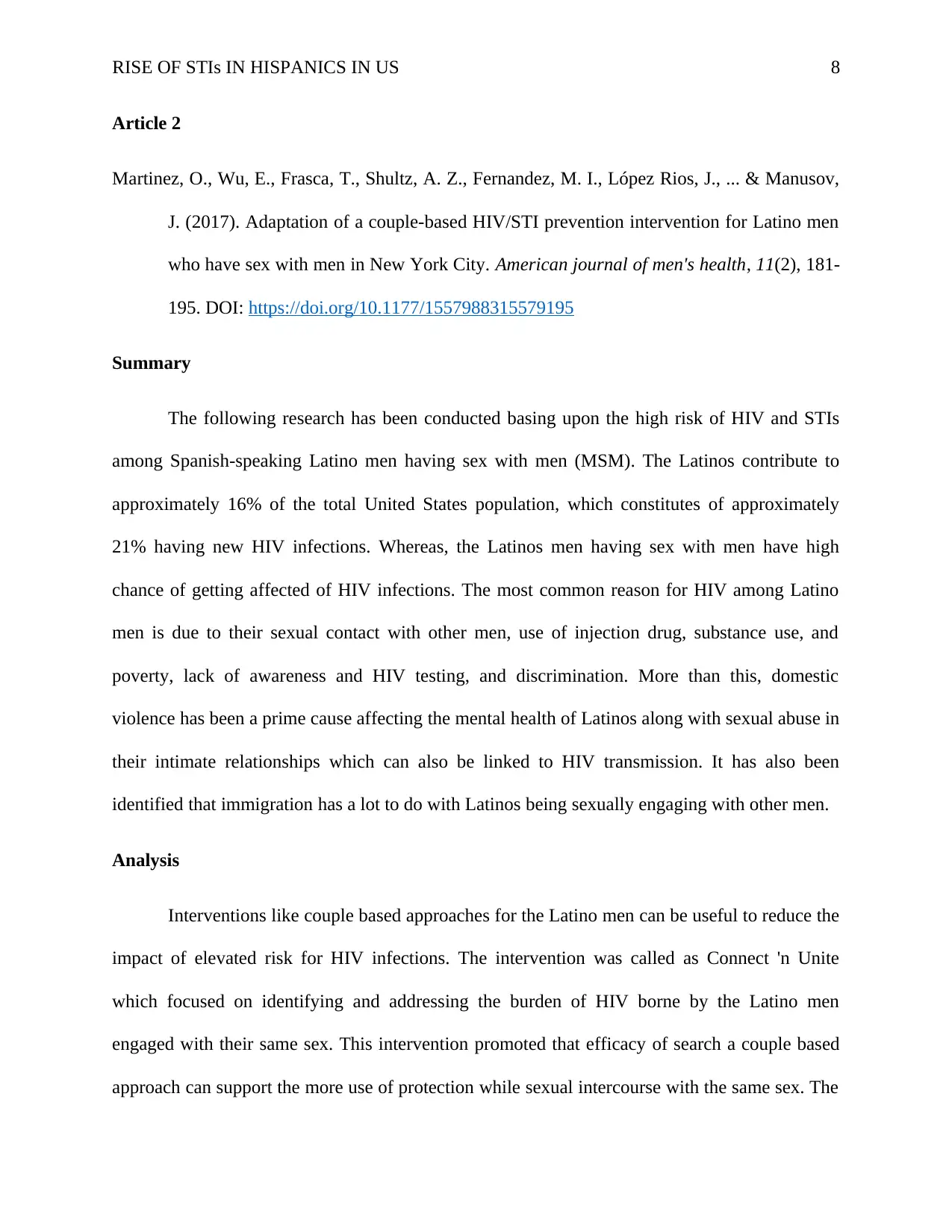
RISE OF STIs IN HISPANICS IN US 8
Article 2
Martinez, O., Wu, E., Frasca, T., Shultz, A. Z., Fernandez, M. I., López Rios, J., ... & Manusov,
J. (2017). Adaptation of a couple-based HIV/STI prevention intervention for Latino men
who have sex with men in New York City. American journal of men's health, 11(2), 181-
195. DOI: https://doi.org/10.1177/1557988315579195
Summary
The following research has been conducted basing upon the high risk of HIV and STIs
among Spanish-speaking Latino men having sex with men (MSM). The Latinos contribute to
approximately 16% of the total United States population, which constitutes of approximately
21% having new HIV infections. Whereas, the Latinos men having sex with men have high
chance of getting affected of HIV infections. The most common reason for HIV among Latino
men is due to their sexual contact with other men, use of injection drug, substance use, and
poverty, lack of awareness and HIV testing, and discrimination. More than this, domestic
violence has been a prime cause affecting the mental health of Latinos along with sexual abuse in
their intimate relationships which can also be linked to HIV transmission. It has also been
identified that immigration has a lot to do with Latinos being sexually engaging with other men.
Analysis
Interventions like couple based approaches for the Latino men can be useful to reduce the
impact of elevated risk for HIV infections. The intervention was called as Connect 'n Unite
which focused on identifying and addressing the burden of HIV borne by the Latino men
engaged with their same sex. This intervention promoted that efficacy of search a couple based
approach can support the more use of protection while sexual intercourse with the same sex. The
Article 2
Martinez, O., Wu, E., Frasca, T., Shultz, A. Z., Fernandez, M. I., López Rios, J., ... & Manusov,
J. (2017). Adaptation of a couple-based HIV/STI prevention intervention for Latino men
who have sex with men in New York City. American journal of men's health, 11(2), 181-
195. DOI: https://doi.org/10.1177/1557988315579195
Summary
The following research has been conducted basing upon the high risk of HIV and STIs
among Spanish-speaking Latino men having sex with men (MSM). The Latinos contribute to
approximately 16% of the total United States population, which constitutes of approximately
21% having new HIV infections. Whereas, the Latinos men having sex with men have high
chance of getting affected of HIV infections. The most common reason for HIV among Latino
men is due to their sexual contact with other men, use of injection drug, substance use, and
poverty, lack of awareness and HIV testing, and discrimination. More than this, domestic
violence has been a prime cause affecting the mental health of Latinos along with sexual abuse in
their intimate relationships which can also be linked to HIV transmission. It has also been
identified that immigration has a lot to do with Latinos being sexually engaging with other men.
Analysis
Interventions like couple based approaches for the Latino men can be useful to reduce the
impact of elevated risk for HIV infections. The intervention was called as Connect 'n Unite
which focused on identifying and addressing the burden of HIV borne by the Latino men
engaged with their same sex. This intervention promoted that efficacy of search a couple based
approach can support the more use of protection while sexual intercourse with the same sex. The
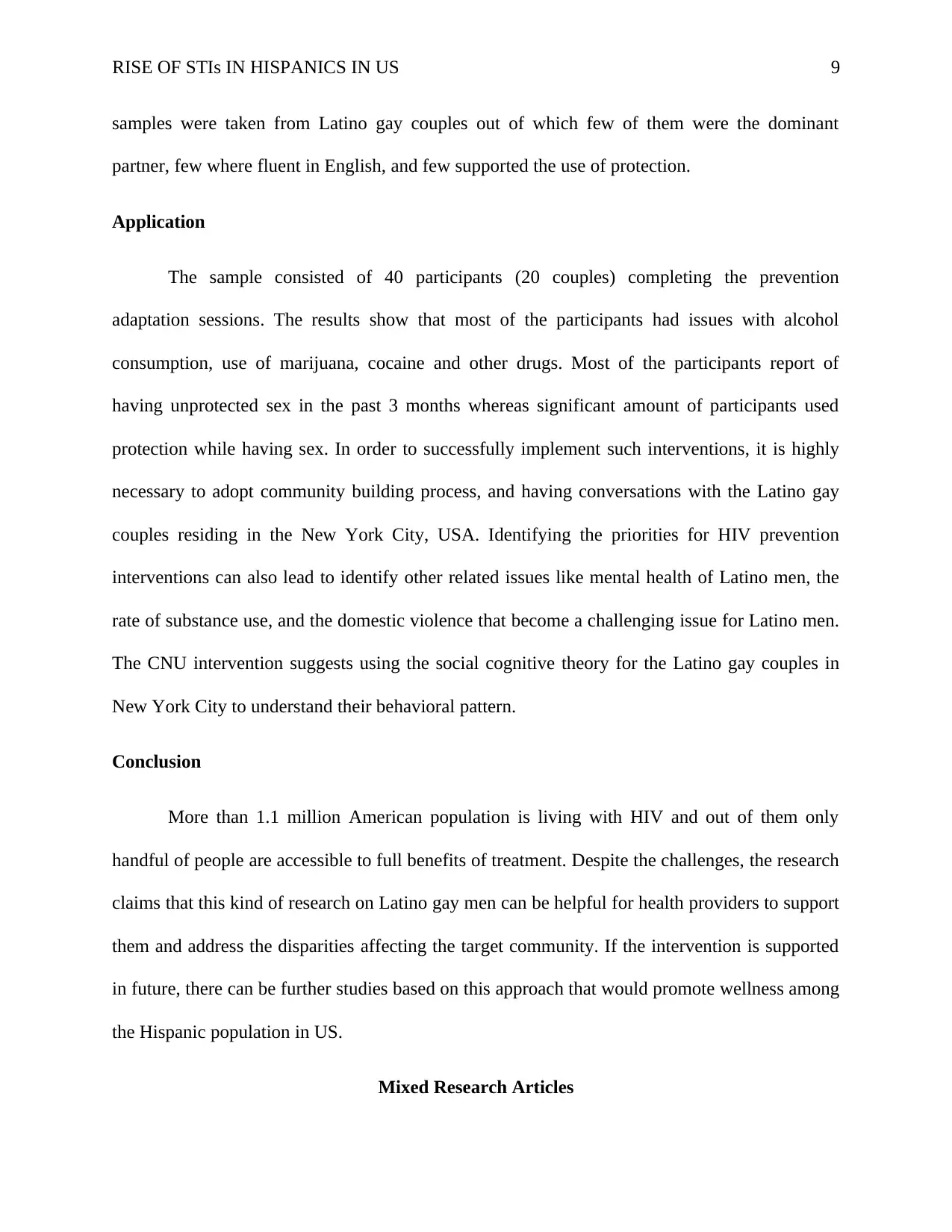
RISE OF STIs IN HISPANICS IN US 9
samples were taken from Latino gay couples out of which few of them were the dominant
partner, few where fluent in English, and few supported the use of protection.
Application
The sample consisted of 40 participants (20 couples) completing the prevention
adaptation sessions. The results show that most of the participants had issues with alcohol
consumption, use of marijuana, cocaine and other drugs. Most of the participants report of
having unprotected sex in the past 3 months whereas significant amount of participants used
protection while having sex. In order to successfully implement such interventions, it is highly
necessary to adopt community building process, and having conversations with the Latino gay
couples residing in the New York City, USA. Identifying the priorities for HIV prevention
interventions can also lead to identify other related issues like mental health of Latino men, the
rate of substance use, and the domestic violence that become a challenging issue for Latino men.
The CNU intervention suggests using the social cognitive theory for the Latino gay couples in
New York City to understand their behavioral pattern.
Conclusion
More than 1.1 million American population is living with HIV and out of them only
handful of people are accessible to full benefits of treatment. Despite the challenges, the research
claims that this kind of research on Latino gay men can be helpful for health providers to support
them and address the disparities affecting the target community. If the intervention is supported
in future, there can be further studies based on this approach that would promote wellness among
the Hispanic population in US.
Mixed Research Articles
samples were taken from Latino gay couples out of which few of them were the dominant
partner, few where fluent in English, and few supported the use of protection.
Application
The sample consisted of 40 participants (20 couples) completing the prevention
adaptation sessions. The results show that most of the participants had issues with alcohol
consumption, use of marijuana, cocaine and other drugs. Most of the participants report of
having unprotected sex in the past 3 months whereas significant amount of participants used
protection while having sex. In order to successfully implement such interventions, it is highly
necessary to adopt community building process, and having conversations with the Latino gay
couples residing in the New York City, USA. Identifying the priorities for HIV prevention
interventions can also lead to identify other related issues like mental health of Latino men, the
rate of substance use, and the domestic violence that become a challenging issue for Latino men.
The CNU intervention suggests using the social cognitive theory for the Latino gay couples in
New York City to understand their behavioral pattern.
Conclusion
More than 1.1 million American population is living with HIV and out of them only
handful of people are accessible to full benefits of treatment. Despite the challenges, the research
claims that this kind of research on Latino gay men can be helpful for health providers to support
them and address the disparities affecting the target community. If the intervention is supported
in future, there can be further studies based on this approach that would promote wellness among
the Hispanic population in US.
Mixed Research Articles
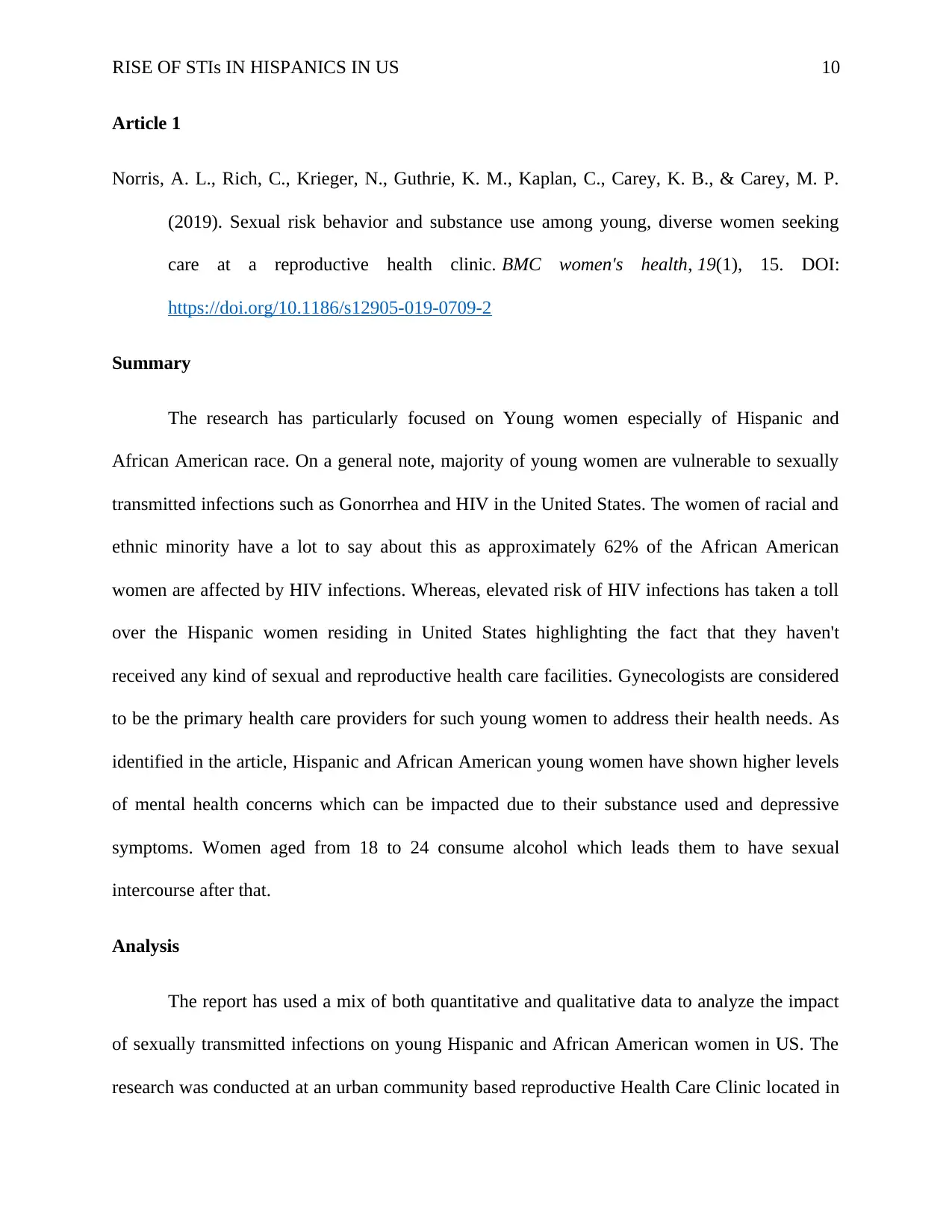
RISE OF STIs IN HISPANICS IN US 10
Article 1
Norris, A. L., Rich, C., Krieger, N., Guthrie, K. M., Kaplan, C., Carey, K. B., & Carey, M. P.
(2019). Sexual risk behavior and substance use among young, diverse women seeking
care at a reproductive health clinic. BMC women's health, 19(1), 15. DOI:
https://doi.org/10.1186/s12905-019-0709-2
Summary
The research has particularly focused on Young women especially of Hispanic and
African American race. On a general note, majority of young women are vulnerable to sexually
transmitted infections such as Gonorrhea and HIV in the United States. The women of racial and
ethnic minority have a lot to say about this as approximately 62% of the African American
women are affected by HIV infections. Whereas, elevated risk of HIV infections has taken a toll
over the Hispanic women residing in United States highlighting the fact that they haven't
received any kind of sexual and reproductive health care facilities. Gynecologists are considered
to be the primary health care providers for such young women to address their health needs. As
identified in the article, Hispanic and African American young women have shown higher levels
of mental health concerns which can be impacted due to their substance used and depressive
symptoms. Women aged from 18 to 24 consume alcohol which leads them to have sexual
intercourse after that.
Analysis
The report has used a mix of both quantitative and qualitative data to analyze the impact
of sexually transmitted infections on young Hispanic and African American women in US. The
research was conducted at an urban community based reproductive Health Care Clinic located in
Article 1
Norris, A. L., Rich, C., Krieger, N., Guthrie, K. M., Kaplan, C., Carey, K. B., & Carey, M. P.
(2019). Sexual risk behavior and substance use among young, diverse women seeking
care at a reproductive health clinic. BMC women's health, 19(1), 15. DOI:
https://doi.org/10.1186/s12905-019-0709-2
Summary
The research has particularly focused on Young women especially of Hispanic and
African American race. On a general note, majority of young women are vulnerable to sexually
transmitted infections such as Gonorrhea and HIV in the United States. The women of racial and
ethnic minority have a lot to say about this as approximately 62% of the African American
women are affected by HIV infections. Whereas, elevated risk of HIV infections has taken a toll
over the Hispanic women residing in United States highlighting the fact that they haven't
received any kind of sexual and reproductive health care facilities. Gynecologists are considered
to be the primary health care providers for such young women to address their health needs. As
identified in the article, Hispanic and African American young women have shown higher levels
of mental health concerns which can be impacted due to their substance used and depressive
symptoms. Women aged from 18 to 24 consume alcohol which leads them to have sexual
intercourse after that.
Analysis
The report has used a mix of both quantitative and qualitative data to analyze the impact
of sexually transmitted infections on young Hispanic and African American women in US. The
research was conducted at an urban community based reproductive Health Care Clinic located in
Secure Best Marks with AI Grader
Need help grading? Try our AI Grader for instant feedback on your assignments.
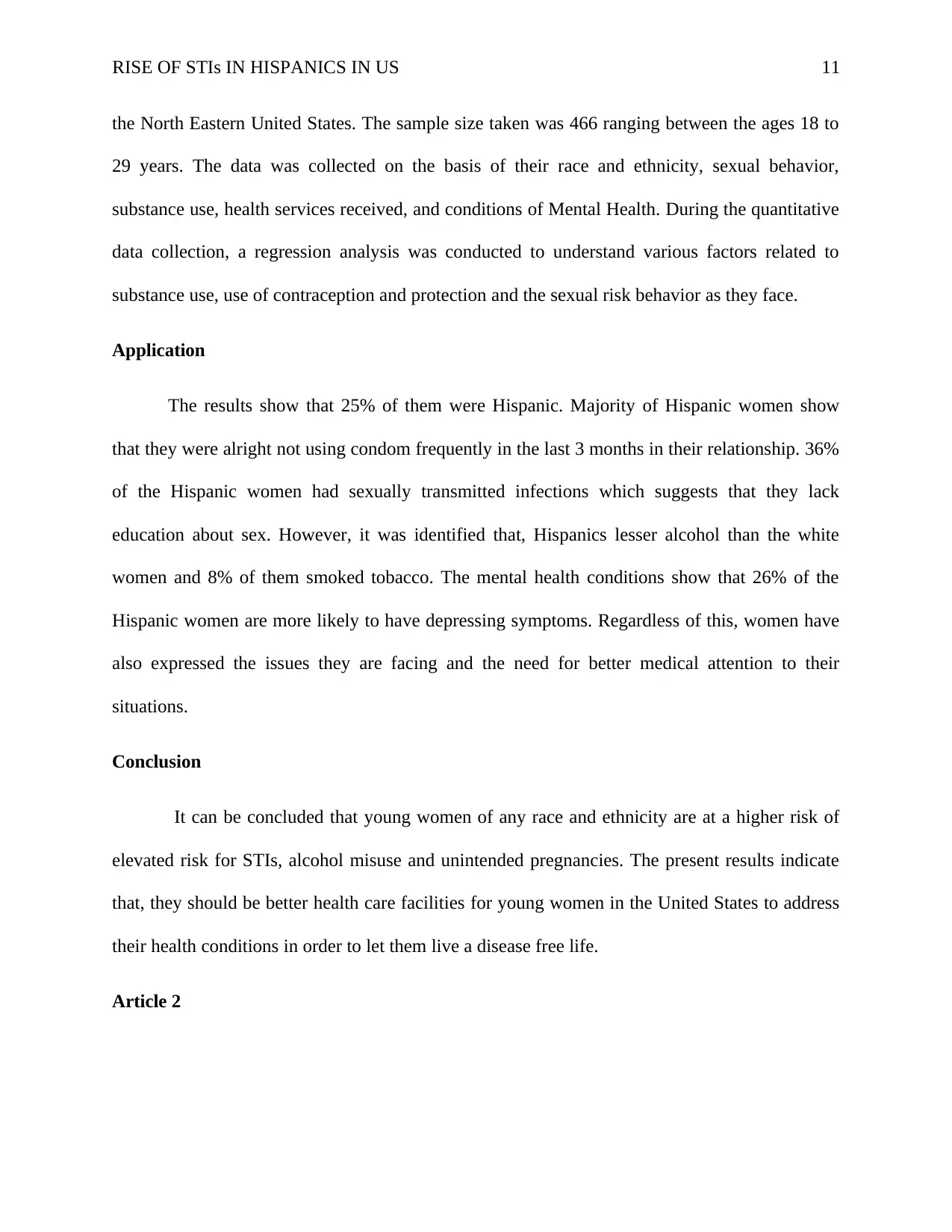
RISE OF STIs IN HISPANICS IN US 11
the North Eastern United States. The sample size taken was 466 ranging between the ages 18 to
29 years. The data was collected on the basis of their race and ethnicity, sexual behavior,
substance use, health services received, and conditions of Mental Health. During the quantitative
data collection, a regression analysis was conducted to understand various factors related to
substance use, use of contraception and protection and the sexual risk behavior as they face.
Application
The results show that 25% of them were Hispanic. Majority of Hispanic women show
that they were alright not using condom frequently in the last 3 months in their relationship. 36%
of the Hispanic women had sexually transmitted infections which suggests that they lack
education about sex. However, it was identified that, Hispanics lesser alcohol than the white
women and 8% of them smoked tobacco. The mental health conditions show that 26% of the
Hispanic women are more likely to have depressing symptoms. Regardless of this, women have
also expressed the issues they are facing and the need for better medical attention to their
situations.
Conclusion
It can be concluded that young women of any race and ethnicity are at a higher risk of
elevated risk for STIs, alcohol misuse and unintended pregnancies. The present results indicate
that, they should be better health care facilities for young women in the United States to address
their health conditions in order to let them live a disease free life.
Article 2
the North Eastern United States. The sample size taken was 466 ranging between the ages 18 to
29 years. The data was collected on the basis of their race and ethnicity, sexual behavior,
substance use, health services received, and conditions of Mental Health. During the quantitative
data collection, a regression analysis was conducted to understand various factors related to
substance use, use of contraception and protection and the sexual risk behavior as they face.
Application
The results show that 25% of them were Hispanic. Majority of Hispanic women show
that they were alright not using condom frequently in the last 3 months in their relationship. 36%
of the Hispanic women had sexually transmitted infections which suggests that they lack
education about sex. However, it was identified that, Hispanics lesser alcohol than the white
women and 8% of them smoked tobacco. The mental health conditions show that 26% of the
Hispanic women are more likely to have depressing symptoms. Regardless of this, women have
also expressed the issues they are facing and the need for better medical attention to their
situations.
Conclusion
It can be concluded that young women of any race and ethnicity are at a higher risk of
elevated risk for STIs, alcohol misuse and unintended pregnancies. The present results indicate
that, they should be better health care facilities for young women in the United States to address
their health conditions in order to let them live a disease free life.
Article 2
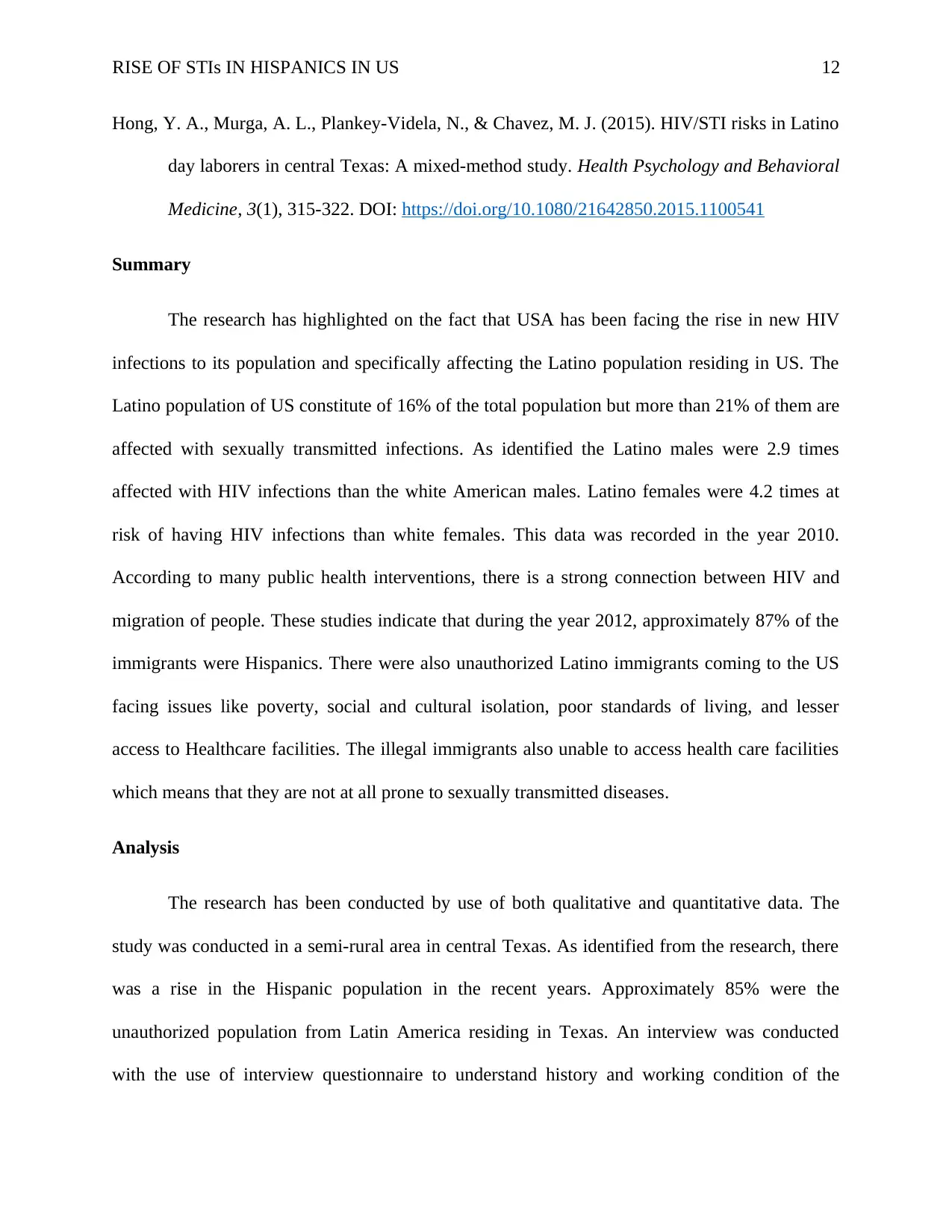
RISE OF STIs IN HISPANICS IN US 12
Hong, Y. A., Murga, A. L., Plankey-Videla, N., & Chavez, M. J. (2015). HIV/STI risks in Latino
day laborers in central Texas: A mixed-method study. Health Psychology and Behavioral
Medicine, 3(1), 315-322. DOI: https://doi.org/10.1080/21642850.2015.1100541
Summary
The research has highlighted on the fact that USA has been facing the rise in new HIV
infections to its population and specifically affecting the Latino population residing in US. The
Latino population of US constitute of 16% of the total population but more than 21% of them are
affected with sexually transmitted infections. As identified the Latino males were 2.9 times
affected with HIV infections than the white American males. Latino females were 4.2 times at
risk of having HIV infections than white females. This data was recorded in the year 2010.
According to many public health interventions, there is a strong connection between HIV and
migration of people. These studies indicate that during the year 2012, approximately 87% of the
immigrants were Hispanics. There were also unauthorized Latino immigrants coming to the US
facing issues like poverty, social and cultural isolation, poor standards of living, and lesser
access to Healthcare facilities. The illegal immigrants also unable to access health care facilities
which means that they are not at all prone to sexually transmitted diseases.
Analysis
The research has been conducted by use of both qualitative and quantitative data. The
study was conducted in a semi-rural area in central Texas. As identified from the research, there
was a rise in the Hispanic population in the recent years. Approximately 85% were the
unauthorized population from Latin America residing in Texas. An interview was conducted
with the use of interview questionnaire to understand history and working condition of the
Hong, Y. A., Murga, A. L., Plankey-Videla, N., & Chavez, M. J. (2015). HIV/STI risks in Latino
day laborers in central Texas: A mixed-method study. Health Psychology and Behavioral
Medicine, 3(1), 315-322. DOI: https://doi.org/10.1080/21642850.2015.1100541
Summary
The research has highlighted on the fact that USA has been facing the rise in new HIV
infections to its population and specifically affecting the Latino population residing in US. The
Latino population of US constitute of 16% of the total population but more than 21% of them are
affected with sexually transmitted infections. As identified the Latino males were 2.9 times
affected with HIV infections than the white American males. Latino females were 4.2 times at
risk of having HIV infections than white females. This data was recorded in the year 2010.
According to many public health interventions, there is a strong connection between HIV and
migration of people. These studies indicate that during the year 2012, approximately 87% of the
immigrants were Hispanics. There were also unauthorized Latino immigrants coming to the US
facing issues like poverty, social and cultural isolation, poor standards of living, and lesser
access to Healthcare facilities. The illegal immigrants also unable to access health care facilities
which means that they are not at all prone to sexually transmitted diseases.
Analysis
The research has been conducted by use of both qualitative and quantitative data. The
study was conducted in a semi-rural area in central Texas. As identified from the research, there
was a rise in the Hispanic population in the recent years. Approximately 85% were the
unauthorized population from Latin America residing in Texas. An interview was conducted
with the use of interview questionnaire to understand history and working condition of the
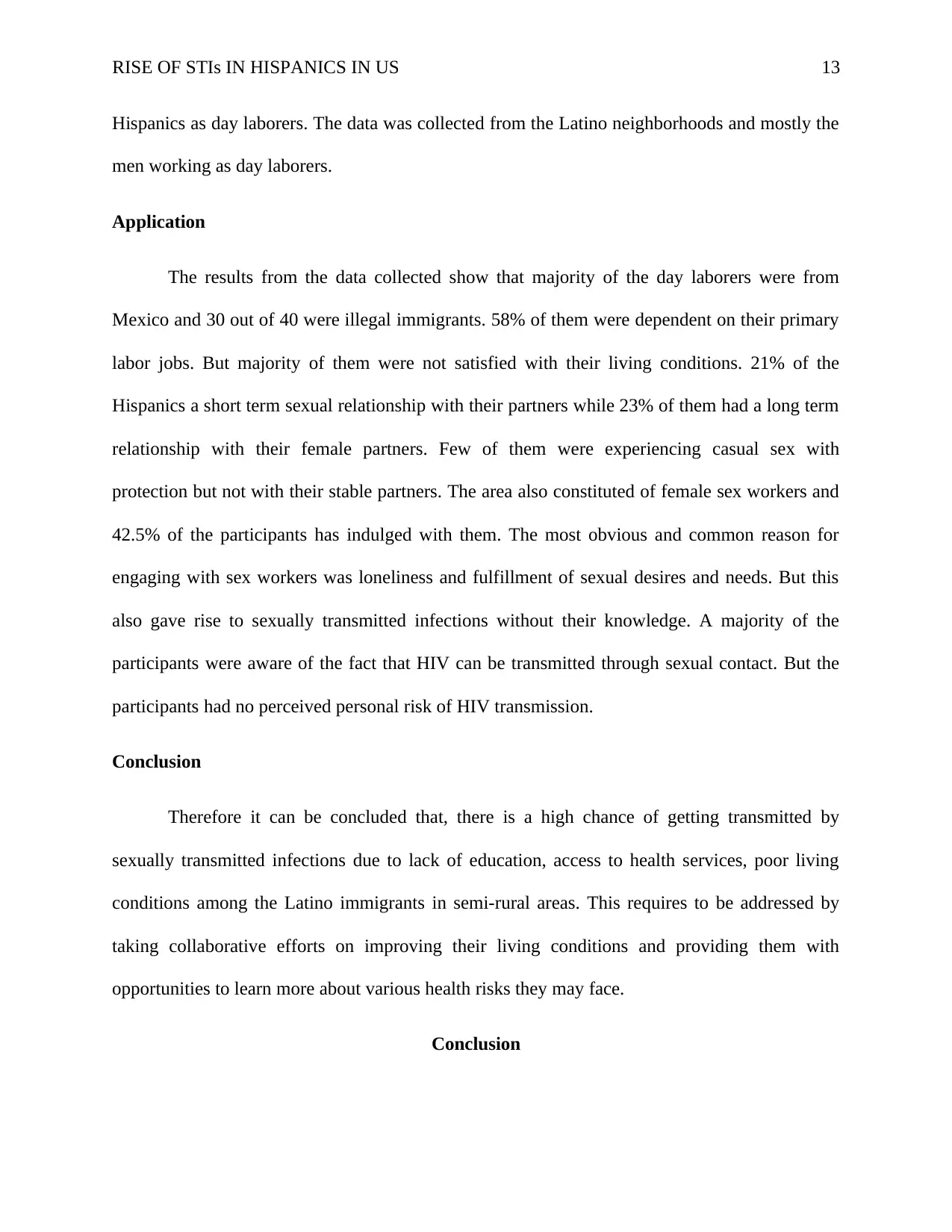
RISE OF STIs IN HISPANICS IN US 13
Hispanics as day laborers. The data was collected from the Latino neighborhoods and mostly the
men working as day laborers.
Application
The results from the data collected show that majority of the day laborers were from
Mexico and 30 out of 40 were illegal immigrants. 58% of them were dependent on their primary
labor jobs. But majority of them were not satisfied with their living conditions. 21% of the
Hispanics a short term sexual relationship with their partners while 23% of them had a long term
relationship with their female partners. Few of them were experiencing casual sex with
protection but not with their stable partners. The area also constituted of female sex workers and
42.5% of the participants has indulged with them. The most obvious and common reason for
engaging with sex workers was loneliness and fulfillment of sexual desires and needs. But this
also gave rise to sexually transmitted infections without their knowledge. A majority of the
participants were aware of the fact that HIV can be transmitted through sexual contact. But the
participants had no perceived personal risk of HIV transmission.
Conclusion
Therefore it can be concluded that, there is a high chance of getting transmitted by
sexually transmitted infections due to lack of education, access to health services, poor living
conditions among the Latino immigrants in semi-rural areas. This requires to be addressed by
taking collaborative efforts on improving their living conditions and providing them with
opportunities to learn more about various health risks they may face.
Conclusion
Hispanics as day laborers. The data was collected from the Latino neighborhoods and mostly the
men working as day laborers.
Application
The results from the data collected show that majority of the day laborers were from
Mexico and 30 out of 40 were illegal immigrants. 58% of them were dependent on their primary
labor jobs. But majority of them were not satisfied with their living conditions. 21% of the
Hispanics a short term sexual relationship with their partners while 23% of them had a long term
relationship with their female partners. Few of them were experiencing casual sex with
protection but not with their stable partners. The area also constituted of female sex workers and
42.5% of the participants has indulged with them. The most obvious and common reason for
engaging with sex workers was loneliness and fulfillment of sexual desires and needs. But this
also gave rise to sexually transmitted infections without their knowledge. A majority of the
participants were aware of the fact that HIV can be transmitted through sexual contact. But the
participants had no perceived personal risk of HIV transmission.
Conclusion
Therefore it can be concluded that, there is a high chance of getting transmitted by
sexually transmitted infections due to lack of education, access to health services, poor living
conditions among the Latino immigrants in semi-rural areas. This requires to be addressed by
taking collaborative efforts on improving their living conditions and providing them with
opportunities to learn more about various health risks they may face.
Conclusion
Paraphrase This Document
Need a fresh take? Get an instant paraphrase of this document with our AI Paraphraser
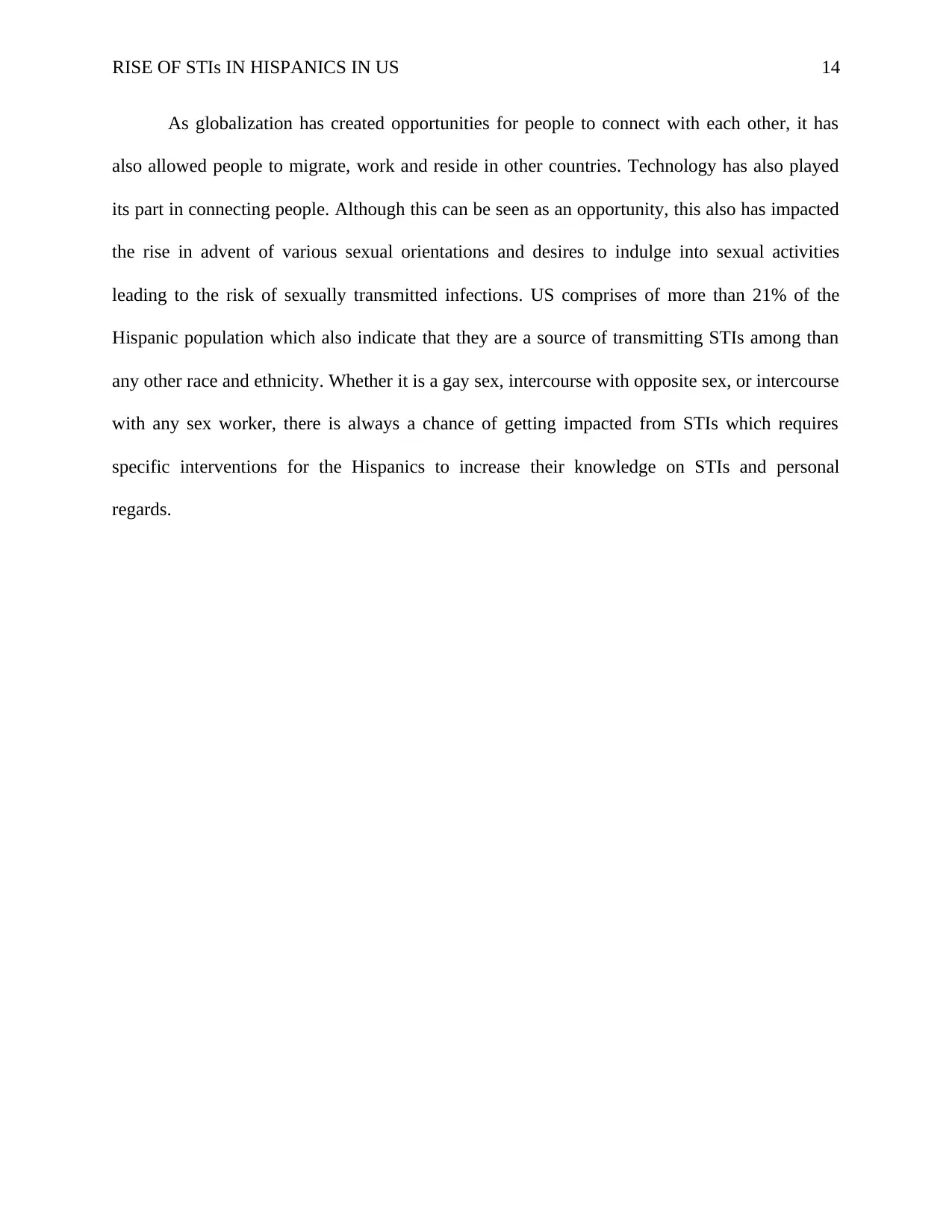
RISE OF STIs IN HISPANICS IN US 14
As globalization has created opportunities for people to connect with each other, it has
also allowed people to migrate, work and reside in other countries. Technology has also played
its part in connecting people. Although this can be seen as an opportunity, this also has impacted
the rise in advent of various sexual orientations and desires to indulge into sexual activities
leading to the risk of sexually transmitted infections. US comprises of more than 21% of the
Hispanic population which also indicate that they are a source of transmitting STIs among than
any other race and ethnicity. Whether it is a gay sex, intercourse with opposite sex, or intercourse
with any sex worker, there is always a chance of getting impacted from STIs which requires
specific interventions for the Hispanics to increase their knowledge on STIs and personal
regards.
As globalization has created opportunities for people to connect with each other, it has
also allowed people to migrate, work and reside in other countries. Technology has also played
its part in connecting people. Although this can be seen as an opportunity, this also has impacted
the rise in advent of various sexual orientations and desires to indulge into sexual activities
leading to the risk of sexually transmitted infections. US comprises of more than 21% of the
Hispanic population which also indicate that they are a source of transmitting STIs among than
any other race and ethnicity. Whether it is a gay sex, intercourse with opposite sex, or intercourse
with any sex worker, there is always a chance of getting impacted from STIs which requires
specific interventions for the Hispanics to increase their knowledge on STIs and personal
regards.
1 out of 14
Related Documents
Your All-in-One AI-Powered Toolkit for Academic Success.
+13062052269
info@desklib.com
Available 24*7 on WhatsApp / Email
![[object Object]](/_next/static/media/star-bottom.7253800d.svg)
Unlock your academic potential
© 2024 | Zucol Services PVT LTD | All rights reserved.





